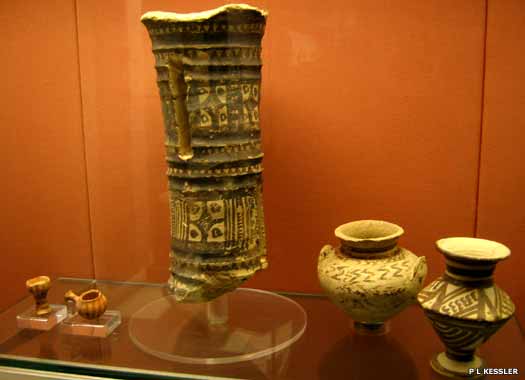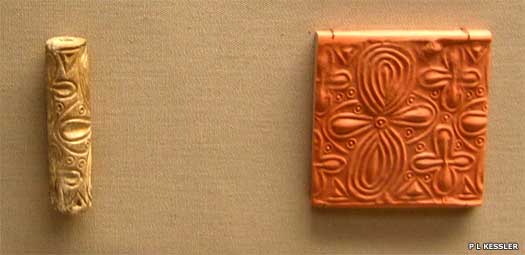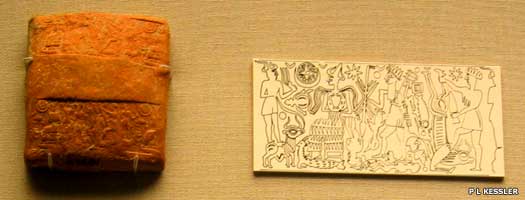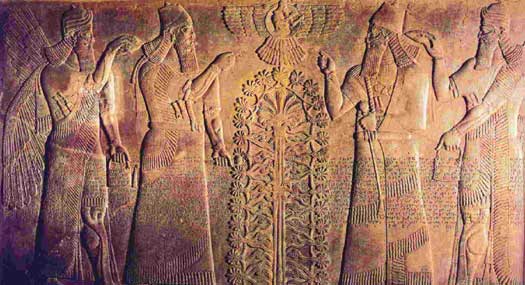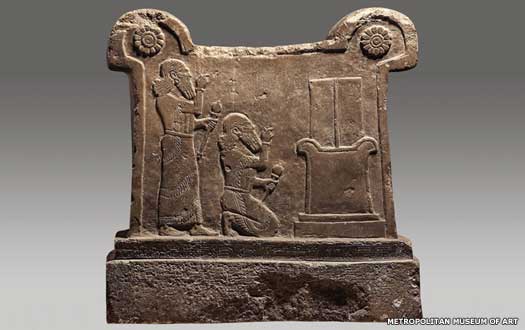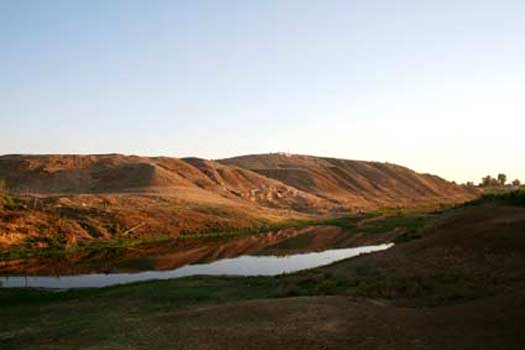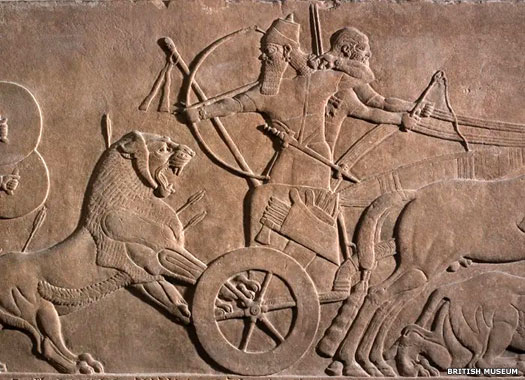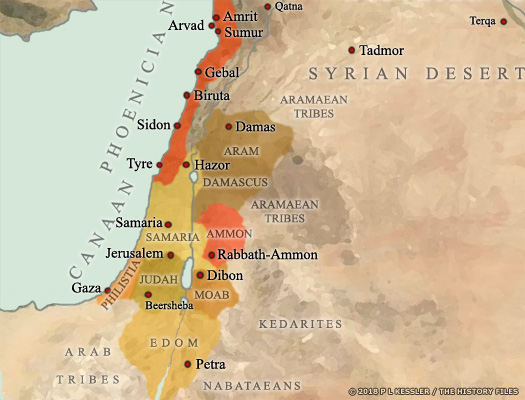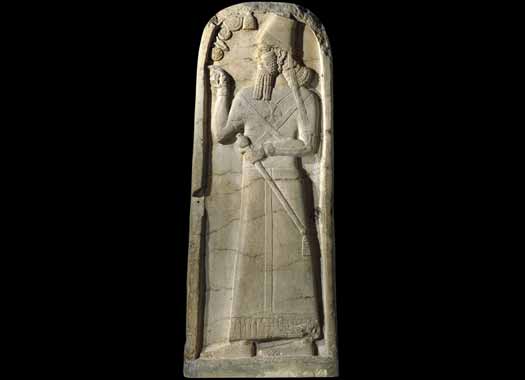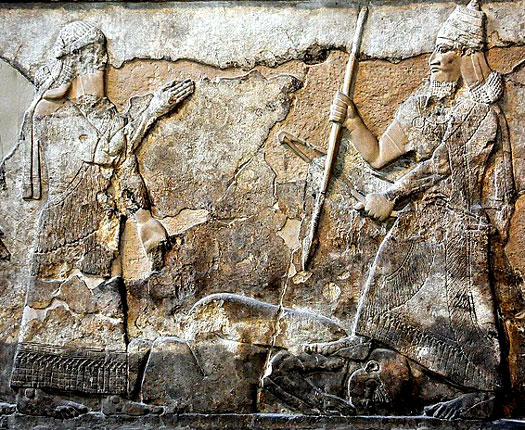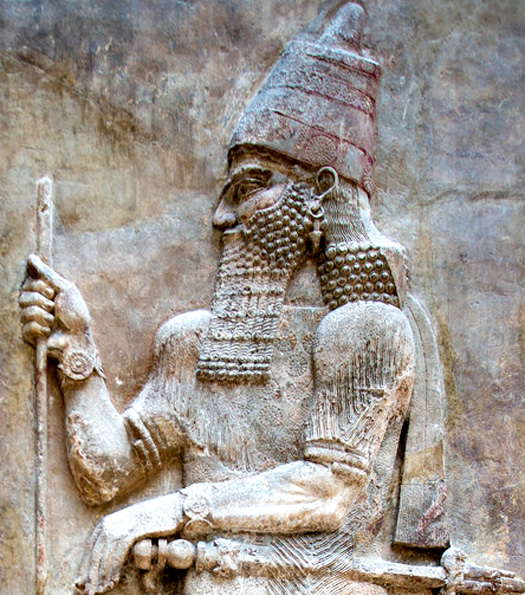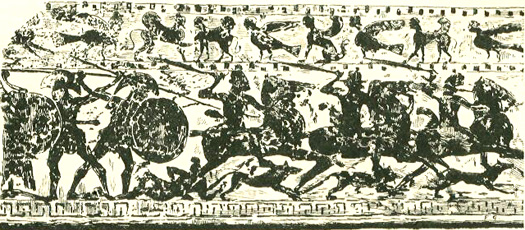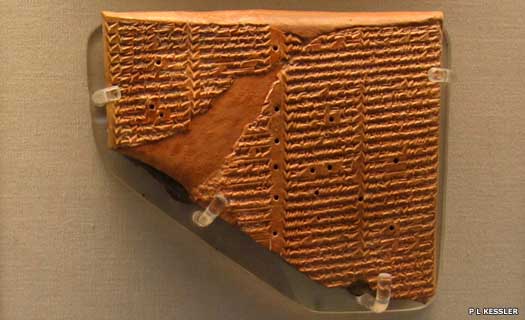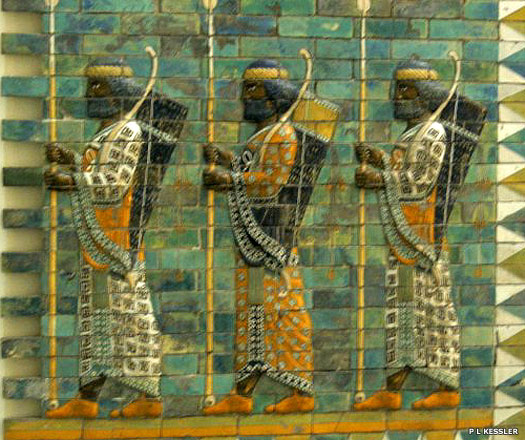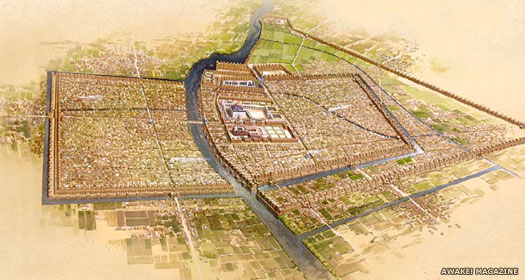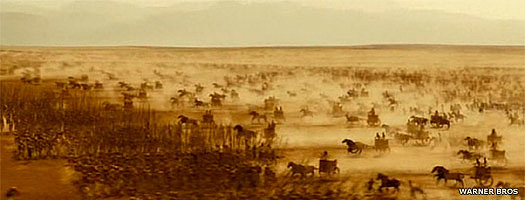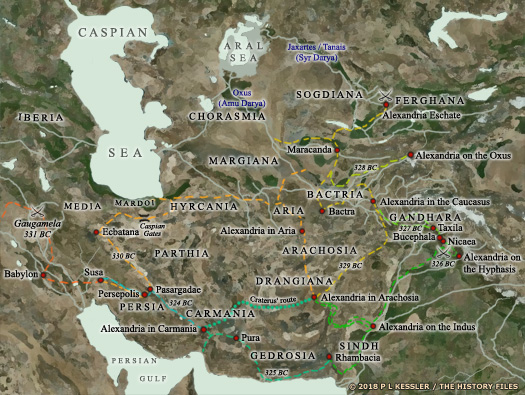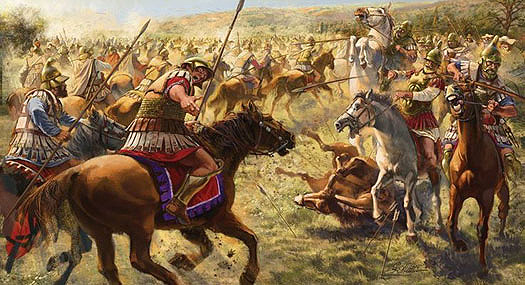
| ASSYRIA The Assyrians were descended from Semitics who had lived in the northern regions of Mesopotamia from at least 5000 BC. Their original home at Ninevah is at least that old, while the other two great Assyrian cities, Ashur and Arbel, were founded soon afterwards. All three were located near a mountainous region which extends along the Tigris as far as the high Gordiaean or Carduchian mountain range of Armenia, which is sometimes known as the 'Mountains of Ashur'. With the rise of Sumerian civilisation in southern Mesopotamia in the fourth millennium BC, the Assyrians benefited as satellite peoples and began to advance their own civilisation.
The Old Testament claims one Asshur as a son of Shem, ancestor of the Israelites, and founder figure of one of Assyria's most important three city states - Ashur. The two, Israelites and Assyrians, shared a Semitic heritage so attempting to link them together in a near-mythical list of ancestors was a valid enough exercise. During the eighteenth century BC the early Israelites were living within the environs of Ur in southern Mesopotamia but their origins before that are entirely unknown.
(Information by Peter Kessler, with additional information by Wayne McCleese (the list of Abraham's ancestors).)
Early Period :
By around 2500-2400 BC the three cities were well established and thriving metropoli, with Arbel being one of the earliest permanent agricultural settlements. Little is known of the early history of these individual city states.
The dates for the earliest listed Assyrians are also unknown, as the document called the Assyrian King List (which was composed by 722 BC) does not show specific dates for each ruler, even though it shows the length of their reign. In fact, incomplete Assyrian king lists have been discovered in every one of the three later capitals. The texts of these copies are more or less consistent and all refer back to one original, which was based on the list of yearly limmu-officials, who were appointed by the king and had to preside over the celebration of the New Year festival.
There is mention in this period (and later) of a polity called Subartu (Šubarri in Assyrian or Subar in Sumerian). It is generally regarded as being an early Assyrian society, one which was situated around the upper Tigris. Subartu was mentioned in the Egyptian Armana letters as Subari and by Ugarit as Šbr.
Kings Who Lived in Tents.
It appears that the author of the Assyrian King List wanted to create the impression that these rulers, with their rhyming, invented names, were nomad kings, whereas the Assyrian city states were already well established, including Ashur, Arbel, and Ninevah.
Ikunum : Not on many of the lists. A confusion with son of Erishum I?
fl c.2350? BC :
Tudiya / Tudia : King of Ashur.
c.2350 BC :
Sumerian king Sargon of Akkad unites all of Mesopotamia, including the Assyrian cities.
Ninevite 5 pottery belonged to a distinctive culture that dates from 2800-2400 BC and immediately predates the era of the kings who lived in tents c.2330? BC :
The king of Ebla concludes a treaty with Tudia which offers him the use of an official trading post over which Ebla would maintain control.
Adamu
Yangi
Suhlamu / Kitlamu
Harharu
Mandaru
Imsu
Harsu
Didanu
c.2193 BC :
The Akkadian empire is destroyed by the invading Gutians as they sweep through southern Mesopotamia and also overthrow Elam. Sumerian/Akkadian domination of the region is ended although the Akkadians survive with minimal power - their decline helped along by a series of very brief, non-dynastic rulers. Both Sumer and Egypt endure a short (climate-induced) dark age at this time, and very little is known about Agade itself until around 2100 BC. The Assyrians are still a minor regional power at this time, but even they, it would seem, suffer at this time. They lose control of the city of Arrapha to the previously-obscure Hurrians.
Hana / Hanu
Zuabu
Nuabu
c.2110 BC :
The Third Dynasty of the Sumerian city state of Ur rises to dominate Mesopotamia.
Abazu
Belu
c.2047 BC :
Ur achieves complete dominance over the Assyrian city states.
Azarah
c.2020 BC :
Ushpia
c.2010 BC :
King Nurahum of Eshnunna receives help from Isin to win a battle against Subartu, generally regarded to be the early Assyrians.
Kings Who Were Ancestors :
It is not clear what is meant by the term 'ancestors' for this section of the list. The kings are listed in reverse order and this is also a mystery. Possibly ancestors should be read as 'my predecessors', but this raises the question of who their descendants may be. As at least two of the early houses were related to them, perhaps it simply means that they were the forefathers of all later Assyrian royal houses.
The author of the list places Apiashal son of Ushpia here, even though he has already been mentioned among the seventeen kings who lived in tents. The timeline in this section seems to be very compressed, so perhaps not all of the names here are direct descendants, but are siblings instead, which fits well with the theory that they were the ancestors of all later royal houses.
Apiashal : Son of Ushpia.
c.2004 BC :
Sumerian civilisation in Ur collapses and a period of chaos follows in southern Mesopotamia. Around the same time, Hurrians found the small state of Arrapha (modern Kirkuk) in northern Mesopotamia at around the same time as they adopt Akkadian cuneiform script for their own language. This would appear to be an eastwards expansion of Hurrians into the territory of the early Assyrians.
Hale : Son. Chief of an Amorite tribe.
Samani : Son.
Hayani : Son.
Ilu-Mer : Son.
Yakmesi : Son.
Yakmeni : Son.
Yazkur-el : Son.
Ila-Kabkaba / Bel-kap-kapu / Belkabi : Son.
c.1840? BC :
Ila-Kabkaba is the Amorite king of the small city state of Ekallatum, whose house is also related to the kings of Babylon. He is also the ancestor (and many sources say father) of Shamshi-Adad (c.1809-1776 BC), founder of the kingdom of Upper Mesopotamia, and of the Adasi Dynasty Assyrian king Shalmaneser I (1274-1244 BC).
A burnt steatite cylinder seal of the Early Dynastic I period in Mesopotamia (around 2800 BC) bearing a design very similar to examples found at Ninevah Aminu : Son.
Kings
Whose Eponyms Are Destroyed :
Sumerian civilisation collapsed in circa 2004 BC and a period of chaos lasting approximately a century engulfed Mesopotamia. During this period the Assyrians city states and small Semitic kingdoms in northern Mesopotamia began to develop and expand. The first inscriptions appear after 2000 BC during which time Assyria remained a minor power, but it established trading colonies at Hattusa and Kanesh in Anatolia, both probably within the territory of the Hatti. The first station on that trading route was Sadduwatum, which was ceded by the Yamutbal to Ekallatum. The probable second and fourth stations were Razama and Qattara respectively.
Sulili / ZuliluI : Son of Aminu? Traditional founder of the Assyrian monarchy.
c.2000 - 1985 BC : Kikkia
c.2000 BC :
The Assyrians establish a trading colony at Kanesh, which may well be within Hattian territorial boundaries, as well as another in Hattusa itself, the Hatti capital. Findings of royal seals with the name of Ibbi-Sin of Ur also suggests that there may be a Sumerian presence here from at least 2025 BC. The local Kütepe period civilisation (2000-1700 BC) which is based at Kanesh is at its height between 1950-1800 BC.
The Kültepe tablets were written by Assyrian traders who were based at Kanesh between 1920-1740 BC, recording business transactions in the Old Assyrian dialect of Akkadian c.1985 - 1970 BC : Akiya
c.1970 - 1960 BC :
Puzur-Ashur I : Possibly Akkadian.
c.1960 - 1945 BC :
Shallim-ahhe / Shalim-Ahu
c.1945 - 1906 BC :
Ilushuma / Ilu-Shuma
c.1940 BC :
The Assyrians begin making raids into central and southern Mesopotamia, attacking Amorite city states including Isin and Babylon. Illushuma is the first Assyrian king to have the power to take a hand in Sumerian and Akkadian affairs.
Old Kingdom Period :
The initial attempt by the Assyrians to create an empire was short-lived. However, the Amorite Shamshi-Adad did found a ruling dynasty which managed to unite the three main Assyrian cities into one political unit, also bringing Arraphka into the Assyrian sphere. Southern Mesopotamia was emerging from the collapse of Sumerian civilisation, with Amorite rulers replacing them in many cases, although the cities in general were reduced from their previous levels of splendour.
Early
Dynasty :
The early kings of Assyria (or priest-princes, as they were often termed) were based at Ashur, which was already the dominant of the three main Assyrian city states. Even during the time of the 'Kings Whose Eponyms Are Destroyed', Ashur had become the capital of a ruling elite. The first three kings especially are also mentioned on texts found in the trading colonies of Hattusa and Kanesh in Anatolia, dealing with a dynastic trading family.
c.1906 - 1867 BC :
Erishum I : Son of Ilushuma of the 'Kings Whose Eponyms Are Destroyed'.
Assyria has trading centres in Hatti city states Anatolia, at least one of which, Kanesh, is conquered by the newly-arriving Hittites. Trade, however, appears to continue between Assyria and Anatolia (although there is no documentary evidence to support this it seems likely that new trading sources in the region would be found). The city of Apum is also part of the Assyrian trade routes at this time. Erishum leaves inscriptions mentioning the building of temples to Ashur, Ishtar, and Adad. The Black Sea port of Sinope could owe its origins to an Assyrian foundation.
c.1867 - 1860 BC :
Ikunum : Son.
c.1860 - 1850 BC :
Sargon I / Sharru-Kin : Son. Not to be confused with Sargon I of Akkad.
c.1850 - 1830 BC :
Puzur-Ashur II : Son.
c.1830 - 1815 BC :
Naram-Sin / Suen : Not to be confused with Naram-Sin of Akkad.
Naram-Sin is also king of Eshnunna, indicating that it and Assyria are united at this time. The suggestion is that unification was achieved through the conquest of Assyria.
c.1815 - 1809 BC :
Erishum II
c.1809 - 1776 BC :
The
dynasty is overthrown by Shamshi-Adad's kingdom of Upper Mesopotamia.
After his death, his son is unable to hold onto most of the conquests,
but Ashur is retained, controlled from Ekallatum.
c.1761 - 1741 BC :
Ekallatum is conquered by Elam in c.1765 BC, so the Assyrians gain temporary new masters who lead them in an attempted conquest of Babylon. A little under four years later, the Assyrians are crushed by the Babylonians. Assyria becomes part of the empire (ruled through Ekallatum until 1741 BC) and vassal kings reign in Assyria for a century or so.
Trade with Anatolia ceases at the same time as the early Hittites are conquering the Hatti in that region. Trade ties are agreed with the city of Apum at about the same time.
c.1760 - 1740 BC :
During this period, Assyrian groups settle alongside Babylonians in the remnants of the city state of Mari.
Vassal
Kings Under Babylonia :
The Babylonian empire of Hammurabi and his descendants ruled all of Mesopotamia from circa 1760 until its fall in circa 1595. Under Babylonian overlordship, Assyrian kings still exercised a certain level of independent action in their governing of the city states, even to the point of having their own period of internecine strife.
c.1740 - 1730 BC :
Mut-Ashkur
c.1730 - 1727 BC :
Rimu-[rest of name unknown]
c.1726 BC :
Asinum
c.1726 BC :
A period of anarchy engulfs Assyria as usurper after usurper grabs the throne. None of them come from the royal house, hence the term, 'son of a nobody'.
c.1726 - 1707 BC :
Puzur-Sin : Usurper.
c.1706 - ? BC :
Ashur-dugal : Usurper. 'Son of a nobody.' All the usurpers classed this way.
Ashur-apla-idi : Usurper.
Nasir-Sin : Usurper.
Sin-Namir : Usurper.
Ipqi-Ishtar : Usurper.
? - 1701 BC :
Adad-salulu : Usurper.
c.1701 BC :
The final usurper replaces Adad-salulu and proves to have more staying power than the rest. Adasi founds a new dynasty, still under Babylonian overlordship.
Adasi
Vassal Kings Under Babylonia :
Adasi came to power in an Assyria which was still being dominated by the Amorite Babylonian empire in southern Mesopotamia. However, his descendants would continue to rule Assyria until 722 BC.
c.1701 BC :
Adasi : Last of the usurpers.
c.1700 - 1691 BC :
Belu-bani : Son.
1690 - 1673 BC :
Libaia : Son.
1673 - 1661 BC :
Sharma-Adad I : Son.
1661 - 1649 BC :
Iptar-Sin : Son.
1649 - 1621 BC :
Bazaia : Son.
1621 - 1615 BC :
Lullaia : 'Son of a nobody.'
1615 - 1601 BC :
Kidin-Ninua / Shu-Ninua : Son of Bazaia.
1601 - 1598 BC :
Sharma-Adad II : Son.
1598 - 1585 BC :
Erishum III : Son.
c.1595 BC :
Babylon's power collapses and the Assyrians probably enjoy a period of independence.
The ability of Assyria's kings to maintain political independence from Babylon during this period was limited 1585 - 1579 BC :
Shamshi-Adad II : Son.
1579 - 1563 BC :
Ishme-Dagan II : Son.
1563 - 1547 BC :
Shamshi-Adad III : Son.
1547 - 1521 BC :
Ashur-Nirari I : Brother.
1521 - 1497 BC :
Puzur-Ashur III : Son.
1497 - 1483 BC :
Enlil-Nasir I : Son.
1483 - c.1475 BC :
Nur-Ili : Son.
c.1475 BC :
The Assyrians are annexed by the Hurrian empire of Mitanni. The kings of the Adasi dynasty again become vassal kings.
Adasi
Vassal Kings Under Mitanni :
The Hurrian empire of Mitanni was situated on Assyria's western border, and it apparently dominated the region at this time, subjugating the Assyrians and ending the Old Kingdom Period. A minor Hurrian state also existed in formerly Assyrian Arrapkha. The early Assyrians at this time may have been part of a polity known as Subartu, which seems already to have existed on the upper Tigris for a millennium, since the Kings in Tents period.
1475 - 1472 BC :
Ashur-Shaduni : Son.
1472 - 1452 BC :
Ashur-Rabi I : Son of Enlil-Nasir I.
1452 - 1432 BC :
Ashur-Nadin-Ahhe I : Son.
c.1440 - 1410 BC :
Saushtatar, ruler of Mitanni and son of Parshatatar, issues a seal which is sent to the ruler of Arrapha to discuss the reorganisation of several minor town governorships. It can be concluded that Ithiya of Arrapha acknowledges Mitanni as his overlord, acts as Mitanni's key representative in the Arrapha region to the east of Mitanni, and also allows an approximate date to be given to his reign. Ashur, which lies on the road from Mitanni to Arrapha is not mentioned at all, showing that the Assyrians are still a very minor, subject group.
1432 - 1426 BC :
Enlil-Nasir II : Brother. Usurped the throne.
1426 - 1419 BC :
Ashur-Nirari II : Son.
c.1415 BC :
The king of Mitanni, Saushtatar, reduces Assyria, and humiliates its inhabitants by sending the doors of the famous temple of Ashur back to Washukkanni. Records of Assyrian rulers after this point become confused.
1419 - 1410 BC :
Ashur-Bel-Nisheshu : Son.
1410 - 1402 BC :
Ashur-Rim-Nisheshu : Son.
1402 - 1392 BC :
Ashur-Nadin-Ahhe II : Son.
c.1392 BC :
The Hittites in Anatolia wrest control of the Assyrians from Mitanni, and the period of vassal kings ends as the Assyrians gain more freedom under their new overlords.
Middle Kingdom Period :
After domination by Mitanni, northern Mesopotamia was dominated by the Hittites. They did not directly annexe Assyrian cities, so the Assyrians had more freedom than before, and after a century of building up their resources, the Assyrians finally rose to become a major power and a leading player in regional affairs from circa 1300 BC.
Dates for rulers between 1420 and 1179 BC are uncertain because there are several lists which don't always agree with each other. The dates used here are the traditional ones from King List A, as opposed to Lists B and C. Dates from 1179 BC are not completely certain but are generally agreed. Some scholars begin the Middle Period from the fall of the kingdom of Upper Mesopotamia.
Adasi
Dynasty :
The core of the Assyrian empire was centred on the capital, which was still Assur (or Asshur). It encompassed what is now northern Iraq (the Ninevah Plains), south-eastern Turkey (from Van southwards), north-eastern Syria, and areas of Iran on the Iraqi/Turkey border. From the reign of Assur-Uballit, the ruler's title was 'king of Assur' in place of the previous 'vice regent (of the god Assur)'.
1392 - 1365 BC :
Eriba-Adad I : Son of Ashur-Bel-Nisheshu.
1365 - 1329 BC :
Assur-Uballit I : Laid the foundations of the new empire.
c.1360 - 1307 BC :
The resurgent Assyrians throw off their overlords, the Hittites. Assur-Uballit establishes firm control over the heartland of Assyria - the Tigris Valley and the plains to the east and from Assur to the Taurus Mountains in the north. In the process, Assyria regains Arrapkha from the Hurrians. The king also exchanges correspondence with Akhenaten of Egypt during his reign (the Armana letters), claiming a status at least equal to that of the king of Mitanni.
1345 BC :
The king of Bablonia is happy to marry the daughter of the powerful Assyrian king, but the marriage leads to the Kassite faction at court murdering their ruler and replacing him with a pretender. Assur-Uballit marches into Babylonia to avenge his son-in-law and raises a new king to the throne.
1329 - 1319 BC :
Enlil-Nirari : Son.
Assyria's power temporarily declines after the death of Assur-Uballit I. His immediate successors are unable to exert international influence. A period of instability follows after invaders from the Taurus mountains, north of Assyria, occupy Arik-den-ili for a number of years, but are then successfully repelled.
1319 - 1307 BC :
Arik-Den-Ili : Son.
1307 - 1274 BC :
Adad-Narari I : Son. First of three successive strong rulers.
c.1300 BC :
The tables are turned on their previous overlords and Assyria becomes the overlord to Mitanni. Adad-Narari I firmly establishes the Assyrian empire.
1274 - 1244 BC :
Shalmaneser I : Son.
c.1270 BC :
Mitanni rebels against Assyrian rule, but their revolt is totally crushed and the Hurrians fall completely under Assyrian control, ending their own distinctive civilisation.
1244 - 1207 BC :
Tukulti-Ninurta I : Son. Possibly the Bible's Nimrod of Babylon. Assassinated.
c.1240? BC :
A second rebellion against Assyrian overlordship in the northern and western areas of Hangilbat (Mitanni) leads Tukulti-Ninurta I to annexe the entirety of northern Syria east of the Euphrates. His forces are left facing the Hittites, but only minor battles are fought between them.
1235 - 1227 BC :
Tukulti-Ninurta begins Assyria's series of regional conquests by capturing Babylonia. After a period of direct rule, puppet rulers are placed on the throne until the Assyrians are thrown out in 1217 BC. Assyrian armies also campaign to the north, in eastern Anatolia, where they first encounter peoples called the Nairi and Uruatri. Tukulti-Ninurta's reign is followed by dynastic struggles within the empire which allows Aramaeans to infiltrate into eastern Anatolia and northern Syria, following years of them being kept at bay.
Shown here is a cult pedestal of the god Nuska which came from from the Temple of Ishtar and was apparently produced during Tukulti-Ninurta's reign 1207 - 1203 BC :
Ashur-Nadin-Apli : Son. Seized the throne from his father.
1203 - 1197 BC :
Ashur-Nirari III : Son.
1197 - 1192 BC :
Enlil-Kudurri-Usur : Son of Tukulti-Ninurta.
1192 BC :
Ninurta-Apil-Ekur follows the route taken by Shamshi-Adad I, seven hundred years before, and seizes the throne.
1192 - 1180 BC :
Ninurta-Apil-Ekur I : Son of Ila-Hadda, descendent of Eriba-adad (1392 BC).
c.1185 BC :
With the fall of Emar in the west, and the internal problems faced by the Assyrians themselves, the border outposts are reduced in size and scribal activity is stopped. The countryside is controlled by Aramaeans, who become prominent in military and political terms.
1180 - 1134 BC :
Ashur-Dan I : Son of Ashur-Nadin-Apli.
c.1150 BC :
Assyria gains power over Syria and Philistia from a weakened Egypt.
1134 BC :
The death of the king brings a short period of instability to Assyria as his sons contest the throne. Elam appears to raid Assyria and Babylonia at will, while the reigns of the sons of Ashur-Dan are very short and peace is only restored by Ashur-Rech-Ishi.
1134 BC :
Ninurta-Tukulti-Ashur : Son. Contested crown with younger brother.
1134 BC :
Mutakkil-Nusku : Brother. Held the throne briefly before he died.
1133 - 1115 BC :
Ashur-Resh-Ishi I : Son. Stabilised Assyria internally.
1115 - 1077 BC :
Tiglath-Pileser I / Tikulti-apal-Esharra : Son.
Tiglath-Pileser campaigns aggressively in all directions, fighting Aramaeans and Mushku in the Syrian west, and preventing the latter from invading Assyria itself, conquering cities such as Amrit and the cities of the Lullubi, raiding Babylonia in the south, and reaching the shores of Lake Van in the territories of Nairi and Urartu in the north, forcing the state of Kummuhu to pay tribute. Babylonia responds, however, by capturing Ekallatum, near Assur, and all the conquests prove to be short-lived.
The modern site of Tell Halaf was, during its existence, later known as Guzana and it also became the capital of the Aramaean kingdom of Bit-Bahiani, despite Assyrian attempts to prevent Aramaeans from settling in Mesopotamia and southern Syria 1076 - 1075 BC :
Ashared-apil-Ekur : Son.
1074 - 1057 BC :
Ashur-bel-kala : Brother.
1076 - 934 BC :
Recent Aramaean migrations into Mesopotamia increase to the point where Assyria is seriously weakened and begins a decline and a century of total obscurity, reduced to its heartland.
1056 - 1055 BC :
Eriba-Adad II : Son.
1054 - 1051 BC :
Shamshi-Adad IV : Son of Tiglath-Pileser. Ousted Eriba-Adad II.
1050 - 1032 BC :
Ashurnasirpal I : Son.
1031 - 1020 BC :
Shalmaneser II : Son.
1019 - 1014 BC :
Ashur-Nirari IV : Son.
Neo-Assyrian Empire Period :
The whole region, from the Hittites in Anatolia, Egypt, Syria and the Levant, through Assyria and into Babylonia, was at this time in the grip of a dark age resulting from the general instability of circa 1200 BC, and a new people, the Aramaeans, were migrating into the surrounding countryside, exacerbating the situation. A major regional drought made the situation even worse. The Aramaean migrations effectively destroyed the Assyrian Middle Empire, and it was a hundred and forty years before the situation settled down with the Aramaeans founding small states of their own, mostly in Syria. Then Assyria was rebuilt by Ashur-Dan II and extended once more by his successors.
(Additional information from A New Luwian Stele and the Cult of the Storm-God at Til Barsib-Masuwari, Guy Bunnens & Isabelle Leirens, from Eden, Bit Adini, and Beth Eden, Alan Millard, from The Persian Empire, J M Cook (1983), from The Routledge Handbook of the Peoples and Places of Ancient Western Asia, Trevor Bryce, and from External Link: The Cities of the Medes, Mordechai Cogan & Israel Eph'al (Eds, The Hebrew University, Jerusalem).)
Ashur-Rabi
Dynasty :
The Neo-Assyrian Empire Period starts from 911 BC, and is the best documented of the three periods. From this point dates are certain.
1013 - 973 BC :
Ashur-rabi II : Son of Ashurnasirpal.
972 - 968 BC :
Ashur-resha-ishi II : Son.
967 - 935 BC :
Tiglath-Pileser II : Son.
935 - 911 BC :
Ashur-Dan II : Son. Rebuilt Assyria within its natural borders.
911 - 889 BC :
Adad-Nirari II : Son.
Adad-Nirari solves the Aramaean problem by conquering them at Nisbin and then marching down the Khabur Valley to obtain submission from a series of Aramaean-controlled cities in Mesopotamia and Syria, including Alep (Lukhuti), Aram-Nahara'im, and Bit-Bahiani.
889 - 884 BC :
Tukulti-Ninurta II : Son.
c.880s? BC :
First in Ctesias' unreliable list of nine kings, Arbaces of the Amadai is said to destroy the Assyrian city of Ninevah at this time. The Assyrians are becoming a dominant force in their region, so this attack may be an attempt to subjugate then and halt their expansion.
884 - 859 BC :
Ashurnasirpal II : Son. Extended Assyria to the Mediterranean.
884 - 870 BC :
Assyria completes its conquest of much of Syria during this period. Assyria also takes areas of Philistia and Urartu, and Carchemish pays tribute in 882 BC, apparently becoming a vassal in 870 BC. A revolt of the Lullubian chiefs of what is now known as Zamua which has been Assyrian territory for the past two and-a-half centuries is put down. This would seem to be the final hurrah for the Lullubi.
Ashurnasirpal II undertook the expansion and recovery of Assyria following general social collapse and a short dark page period between about 1200-900 BC 859 - 824 BC :
Shalmaneser III : Son. Killed Ahab of Samaria in battle in 840s.
857 - 856 BC :
Fresh tribute is received from Carchemish and is exacted from Sam'al. In the following year, Bit Adini is conquered. Also likely to occur in this century (although a precise date is unknown), the neo-Hittite state of Hiyawa becomes an Assyrian client state.
853 BC :
Assyria fights the Battle of Qarqar against twelve Syrian and Canaanite kings, including those of Ammon, Arvad, Byblos, Damas, Edom, Egypt, Hamath, Kedar, and Samaria. The battle consists of the largest known number of combatants to date, and is the first historical mention of the Arabs from the southern deserts. Despite claims to the contrary, the Assyrians are defeated, since they do not press on to their nearest target, Hamath, and do not resume their attacks on Hamath and Damas for about six years. However, in the same year, Babylonia and the rich area of southern Mesopotamia is taken, as is Gan Dunias.
When the Neo-Assyrian empire threatened the various city states of southern Syria and Canaan around 853 BC, they united to protect their joint territory - successfully it seems, at least for a time 848 BC :
The king of Samaria is killed. The following year, the city of Hamath is conquered and local governors or vassal kings are installed there.
c.843 BC :
The early Persians or, perhaps more accurately, the Parsua, receive their first mention in history. Shalmaneser III records their existence on the Black Obelisk, which covers his campaign of about this year. Their position is not precisely fixed but 'Pasua' seems to lay in what is now Iranian Kurdistan (immediately east of Kurdistan in northern Iraq), far to the north of Persis and the heart of Persian settlement.
It may be the case that there are two (or perhaps even three) distinctive groups of 'Parsua' at this time, primarily in the Zagros Mountains to the east and south-east of the Assyrians. This is apart from a larger body which is settling the land immediately to the east of Elam (and focussed around the city of Persis). Those groups in the Zagros seem to drop out of the historical record, perhaps pushed south by the greater numbers of the Medes or absorbed by them.
837 - 836 BC :
Shalmaneser III records that he receives gifts from the twenty-four kings of Tabal. The following year (836 BC, sometimes given as 835 BC) the Medes and Mannaeans are mentioned for the first time in historical records when the king receives tribute from the 'Amadai' after fighting wars against the tribes of the Zagros Mountains. At this time Assyria is relatively weak, and the rise of Urartu to the north threatens Assyria when the new enemy also conquers the Zagros Mountains to the east.
832 - 827 BC :
Shalmaneser III organises a series of five campaigns against Urartu in a concerted attempt to halt its expansion. Rather than lead the campaigns himself, as is the custom, he places his general, Dayyan-Assur, in command. This causes a growing sense of discontent among princes in Assyria that leads to rebellion in 827 BC. Fighting for the right of succession, the confusion in the heart of the empire lasts for seven years, including the first three of the reign of Shamshi-Adad V, who gains the throne with the help of Babylonia.
823 - 811 BC :
Shamshi-Adad V : Son.
820 BC :
Although the rebellion in Assyria has ended, the new king finds that his country's dominance over Syria has entirely disappeared. Even the city of Mari is being ruled by Assyrian governors who claim royal descent for themselves. Worse still, an attack against the Urartuans is repulsed, making this northern enemy even stronger.
Shown here is a stela which has been dated to the reign of Shamshi-Adad V of Assyria and which was discovered at the site of Kalhu in the mid-nineteenth century AD 811 - 783 BC :
Adad-Nirari III : Son.
811 - 805 BC :
Shammu-ramat / Semiramis : Regent.
c.796 BC :
Damas is attacked and tribute is forced from its weak king, Ben-Hadad III. The Assyrian commander-in-chief, Shamshi-ilu, is perhaps the most powerful man of his time, one of a small group of almost equally powerful magnates - princes who govern Assyria under the sovereignty of Adad-Nirari and his three immediate successors. Making Kar-Shulmanu-Ashared his base, he campaigns west of the Euphrates on his own behalf without reference to the king.
783 - 773 BC :
Shalmaneser IV : Son of Adad-nirari II.
773 - 755 BC :
Ashur-Dan III : Son.
755 - 745 BC :
Ashur-nirari V : Son of Adad-nirari II.
752 BC :
The Aramaeans had brought a new method of writing with them, on parchment, leather, or papyrus, and its success now sees their language, Aramaic, supplant ancient Assyrian, although in a heavily Akkadian-influenced manner. Aramaic is made the second official language of the Assyrian empire.
745 - 727 BC :
Tiglath-Pileser III : Son. Ruled Babylonia direct (729-727 BC).
745 BC :
Tiglath-Pileser's ascension to the throne marks a change in how the empire is governed. He rules in a far more direct fashion than any other Assyrian king of this century, taking personal command of the various campaigns and removing the princes who had taken so much authority upon themselves. The indirect governance of Kar-Shulmanu-Ashared as a base for Shamshi-ilu, the all-but independent Assyrian king of the west, is also ended.
744 BC :
The Medes to the west of the Gizilbunda Mountains (part of the Zagros range) have enjoyed a respite in the past few years. Now a new Assyrian advance begins when the king invades Parsuai and turns it into an Assyrian province (also known as Nikur, after its capital). This refers to Parsua, but not those of southern Iran. This is one of the northern groups which had settled in the Zagros Mountains. Nikur may not be too far to the west from the later city of Ecbatana.
Possibly in the same year the Assyrians make a raid farther to the east, reaching Arazias, and a Median fortress called Zakruti. Tiglath-Pileser demands that in the whole country of the mighty Medes as far as Mount Bikni (possibly Mount Demavend close to modern Tehran), the 'lords of townships' should pay him regular tribute of nine metric tons of lapis lazuli and fifteen tons of bronze artefacts, an impossible order to fulfil.
743 - 740 BC :
Tiglath-Pileser III besieges Arpad for three years as it is an ally of Urartu. Once captured, the city is destroyed and its inhabitants are massacred. Arpad is never repopulated. It is probably around this period that the Urartuans lose their domination of the northern part of Syria (with the result that rulers of minor states there are forced back into Assyrian vassal status, such as Gamgum).
Additionally, Ammon is made a vassal around this time and Tabal is attacked. Tabal is still divided into several independent principalities, but all of them are sizeable enough to merit the use of the title 'king' for their rulers even though Assyrian vocabulary has now extended beyond using it for every ruler they meet.
738 BC :
The city of Byblos pays tribute to Assyria, and Tiglath-Pileser campaigns in Sam'al against a rebellion there. He also captures Samaria and Damas and makes them vassal cities.
Tiglath-Pileser III dominated the Levantine city states during the later years of the eighth century BC, terminating the kingdom of Samaria and, shown here, with his foot on the shoulder of Hanunu of the Philistine city of Gaza, a gesture of dominance in the face of Hanunu's crouched submission 734 - 732 BC :
In the 730s BC, Midas of Phrygia conquers several fortresses in the west of the state of Hiyawa (Que). The act seems to go unpunished by the Assyrians who are the overlords of Hiyawa, possibly because Tiglath-Pileser III is heavily involved in campaigns in Syria. This may be one of the earliest incidents to involve Midas as a significant nuisance factor for Assyria.
Between 734-732 BC, Tiglath-Pileser III marches an army into Syria and the Levant and over the next two years he re-conquers all the rebellious states there. The Samarian city of Hazor is captured in 733 BC, as is the kingdom of Judah, and Damas is captured and destroyed in 732 BC. Around two years later, Moab is made a vassal.
727 - 722 BC :
Shalmaneser V : Son. Ruled Babylonia direct.
c.726 - 720 BC :
The last king of Hiyawa is Warikas (known in Assyrian as Urikki). Previously a loyal servant of the empire, he throws off the shackles of Assyrian domination. The result is Assyrian invasion, the defeat of Hiyawa and the removal of its king, and its incorporation into the empire as a province named Que. The date of this event is uncertain, and it may be that several years elapse from the rebellion of Warikas to the fateful invasion. The events take place either during the poorly documented reign of Shalmaneser V or at the very start of the reign of Sargon II.
724 - 722 BC :
Two years after conquering Edom, Shalmaneser V is the last name on the Assyrian King List, which is composed around this time. He is dethroned by a coup d'etat headed by Sargon II.
Sargonid
Dynasty :
The usurping Sargonids formed the last great dynasty of Assyrian rulers. They extended the empire to its greatest extent; from the Caspian Sea to Cyprus, and from Anatolia to Egypt. Their systematically trained and equipped armies proved almost irresistible to their opponents. Following Sargon's seizure of the throne, the Assyrians were all-powerful for up to a century, fighting everyone and everything in their way. That aggressiveness proved to be their undoing, however. By the middle of the seventh century they had worn themselves out with constant wars of aggression. Not at all coincidentally, dating from 649 BC is more uncertain, as increasing discord and chaos hit the empire. Egypt was a conquest too far, the protectorate that was Babylon was a running sore, and Elam needed constant reminders of who was in charge. Campaigning in the Zagros Mountains became an impossibility, and it was here that new arrivals, the Medes, were building a power base.
(Information by Peter Kessler, with additional information by Wayne McCleese, from Europe Before History, Kristian Kristiansen, from The History of Esarhaddon (Son of Sennacherib) King of Assyria, BC 681-688, Ernest A Budge, from The Persian Empire, J M Cook (1983), from Unger's Bible Dictionary, Merrill F Unger (1957), from Easton's Bible Dictionary, Matthew George Easton (1897), and from External Links: Metropolitan Museum of Art in New York, USA, and Encyclopaedia Britannica.)
722 - 705 BC :
Sargon II / Sharru-kîn II : (Sargon I being the king of Akkad.) Killed trying to regain Tabal.
722 - 720 BC :
Sargon destroys and subsumes Israel (Samaria), Moab, Ammon, Philistia, and the Meunites (south-west of Judah), conquers Alashiya, and suppresses a rebellion in Hamath. He also continues the Assyrian policy of mass relocations of subjugated people by forcing the Hebrews out of Israel. The campaign against Samaria is actually handled by his son, Sennacherib, with a co-regency being suspected.
Sargon II usurped the Assyrian throne, seizing it from the last of the Ashur-Rabi monarchs, but he brought with him Assyrian resurgence and a drive to expand the empire 720 BC :
While attempting to attack Elam, Sargon is defeated by the Elamites and Babylonians near Der. It seems likely that another attack is mounted in 713 BC, as Sargon is surprised by a rebellion in Tabal while his attention is focussed on Elamite lands.
c.717 BC :
Assyria places one of its own people on the throne of Carchemish.
715 BC :
Despite sharing culinary and aesthetic tastes, Assyria and Phrygia are on bad terms. Although there are no relevant sources prior to Sargon's reign, his own inscriptions describe Midas of Phrygia as having long been a thorn in the empire's side, having never submitted to Sargon's predecessors and refusing diplomatic contacts. Now, Sargon's army conquers some fortresses in western Que that Midas of Phrygia had taken 'very long ago', indicating that Midas must have been in power for some time. This campaign results in an Assyrian foray deep into Phrygia but does not stop Midas from his continuing intervention in Que and Tabal.
714 - 713 BC : Much to Sargon's shock, while the main Assyrian army is occupied in the east, probably in Elamite lands, Ambaris of Tabal allies himself with Midas of Phrygia and Rusa of Urartu as well as the local Tabalean rulers in an attempt to invade Que. Sargon reacts quickly, invading Tabal and capturing Ambaris, his family and the nobles of his country, all of whom are taken to Assyria. Tabal is annexed as an Assyrian province. Sargon is noted for using Cimmerians within his army on this campaign, possibly for their knowledge of the Urartuan hills as much as their ability as mounted warriors. Cimmerians have been raiding into Mesopotamia for decades.
This image shows Cimmerians battling early Greeks - prior to the advent of accepted 'Classical' Greece - with the mounted Cimmerians warriors apparently being accompanied by their dogs In the same year, 713 BC, Sargon receives the submission of forty-five Median city chiefs, and he claims to have i9ncorporated thirty-four districts of the Medes in his realm. Fortified cities have already begun to appear in strategic locations in the Zagros Mountains, built by Assyria which now reduces the region to three provinces in an attempt to control the trade route along the Khorasan road. Assyria's political control is incomplete, and various small groups of Medians remain independent. The Medes are already starting to absorb the non-Iranian peoples in the upper valleys of the Zagros.
712 BC :
The
capital city of the neo-Hittite state of Kummuhu is sacked
by Sargon, ending that state's prosperity.
711 BC :
The creation of the province of Tabal has only further escalated the situation and Assyria now finds itself at war with assorted Tabalean principalities and Phrygia, and moreover increasingly on the losing side. Despite huge investments in the protection of the new border, including the fortification of Til-Garimmu (modern Gürün) and the construction of the so-called Cappadocian Wall, the province of Tabal is now lost, never to be retaken.
710 - 705 BC :
Thwarted in Anatolia, Sargon rules Babylonia direct, dispensing with the sub-kings there. Assyria also conquers Cyprus (thanks to a request by the king of Tyre) and Moab, Assyrian governors replace local dynasties in Carchemish and Damas, and Gamgum is conquered at some point in Sargon's reign. Sargon dies on the battlefield while attempting to reconquer Tabal. Not only does the attempt fail but Sargon's body cannot be recovered for burial.
705 - 681 BC :
Sennacherib / Sin-ahhe-eriba : Killed by sons for sacking Babylon in 689 BC.
704 - 701 BC :
With the death of Sargon, many of the former subject states rebel, especially Chaldaeans and neighbouring groups. Amongst the rebels are listed the Hagaranu (possibly the descendants of Hagar, the mother of Ismael), the Nabatu (very possibly the descendants of Nebayoth, the eldest son of the same Ismael), and the Kedarites (descendants of Ismael's second son). According to the records, these tribes flee from Assyria into the Arabian Desert and cannot be conquered. The use of 'tribes' here may be misleading. The Kedarite kingdom at least is already in place, so these may be captured and transported slave groups instead. With the recapture of Babylon a priority, it takes the Assyrians until 701 BC to get around to quelling similar rebellions in Judah and the Phoenician states.
692/691 BC :
Sennacherib fights his eighth campaign against a confederation from the east. He is confronted by Elam, along with Babylon, Anshan, Ellipi (roughly located in the Luristan region immediately to the west of Elam), and the Parsua or Parsuash (Persians). Despite fighting the Battle of Halule on the Tigris (suggesting a march by the allies towards the heart of Assyrian-dominated territory), Sennacherib is unable to gain a decisive victory.
689 - 669 BC :
Two years after fighting an indecisive battle against Elam and devastating Babylon, Assyria takes direct control of Babylonia in 689 BC. In 676 BC all of Phoenicia is also conquered, including the major cities of Arvad, Biruta, Byblos, Sidon, and Tyre.
681 - 669 BC :
Esarhaddon / Ashur-aha-iddin : Son.
679 BC :
Esarhaddon conducts a campaign against the Cimmerians. He defeats them and their leader, Teuspa, in the region of Hubusna (probably Hupisna-Cybistra), but the area is not pacified. In the same year Esarhaddon's troops also fight a war in Hilakku (Khilakku), and a few years later they punish the Anatolian prince of Kundu (Cyinda) and Sissu (Sisium, modern Sis), who has allied himself with Phoenician rebels against Assyrian rule. The regions to the north of the Cilician plain repeatedly cause trouble for Assyria.
It would seem to be during this period that Esarhaddon ends local rule in at least one of his subject cities - Yadiya-Sam'al - presumably because a loyal governor is easier to manage than a king with thoughts of his own.
By this time, the non-Iranian peoples of the upper valleys of the Zagros are disappearing under progressive absorption by the dominant Medes. Small kingdoms such as Ellipi and Harhar are disappearing from the historical record. Even the names of petty rulers who retain independence show a progressive process of medisation.
669 BC :
Upon the death of Esarhaddon, the Assyrian empire goes to his son, Ashurbanipal. His other son, Shamash-shumi-ukin, rules Babylon as a semi-independent kingdom for his lifetime.
Ancient Mesopotamian names were always meaningful, such as that of Esarhaddon, 'The- god-Ashur-has-given-a-brother', and were therefore translatable into other languages, as with this tablet, which records many exotic, non-Akkadian names in Akkadian 669 - 627 BC :
Ashurbanipal / Ashur-ban-aplu : Son. Died 627 BC.
664 - 663 BC :
With the sacking of Thebes, the Assyrians complete their conquest of Egypt, making it a vassal state with subject pharaohs. Fighting is recorded against the 'Nabaiateans', with the likelihood that Kedar is also involved.
653 BC :
The Cimmerian king, Tugdamme, begins to threaten the borders of the powerful Assyrian empire during the reign of Ashurbanipal. Assyrian inscriptions record him as being 'King of the Saka and Qutium' (Sakas in this case being Scythians). Assyrian inscriptions also refer to Tugdamme as 'Sar Kissati' which translates as 'King of Kish' or 'King of the World'. Kish is an ancient and highly important city state in southern Mesopotamia, which suggests that Tugdamme now rules a vast area of land to the east and south of the Assyrians.
652 BC :
One serious invasion of Anatolia by Cimmerians has already been repulsed, with the states or regions of Hilakku, Lydia, and Tabal requesting help from Assyria. Now the Cimmerians return (leader unknown). King Gyges of Lydia is killed during a second attack. His capital of Sardis is captured, all except the citadel which manages to hold out. The fact that it does suggests either that either the Cimmerians do not hang around for long after their victory or that (as before) they are moved along by an Assyrian force. Excavations at the site of Sardis later discover a destruction layer that appears to be associated with this event.
649 BC :
After his brother rebels in 652 BC, Ashurbanipal besieges Babylon, bringing it back into the empire. Rebellions in support of Babylon by the Kedarites and Nabatu are also put down, possibly prior to Babylon's recapture. Ashurbanipal has already proven himself to be not only a hunter, but also a warrior, taking great pride in being able to read and write at a time when usually only scribes mastered the intricacies of cuneiform writing. He has amassed a huge library of clay tablets, which his agents have collected from throughout the empire to store in the great library in Babylonia.
644 - c.620 BC :
After conquering Kedar, the Assyrians devastate Elam, to all intents and purposes ending one of the longest-surviving kingdoms. By around 620 BC, with Assyria rapidly weakening, Media takes control of the region.
631 - 627 BC :
Ashurbanipal has twin sons, and he appoints Ashur-etil-ilani as his successor. The other twin, Sin-shar-ishkun, does not recognise this and so begins a civil war that lasts until he gains the throne. This proves divisive for Assyria, and its control over the Levant slips by 630 BC, while the vassal ruler in Babylonia disappears in 627 BC.
631 - 627 BC :
Ashur-etil-ilani : Twin son. Forced to withdraw to west in 626. Died 621?
627 - 612 BC :
Sin-shar-ishkun : Twin brother. Did not recognise his brother's rule.
627 - 626 BC :
The Babylonians revolt against Assyrian control, something which spirals out of all control and threatens the very heartland of Assyria. The empire also loses control of Amrit, on the Mediterranean coast.
626 BC :
Sin-shumu-lishir : Rival in Babylonia.
616 - 614 BC :
Assyria is invaded by the Babylonia in 616 BC, and two years later, Ashur falls to the Medes. The Egyptians also begin a two year battle to free themselves from Assyrian rule.
612 BC :
The empire collapses with the fall of Kalakh and Ninevah to Media and Babylonia, supported by Egypt and groups such as the Scythians, who divide the spoils between them. Sin-shar-ishkun dies in his burning palace in Babylonia, where Ashurbanipal's great library crashes into the room below, with many of the baked clay tablets surviving to be discovered by later archaeologists.
The commander of the Assyrian western army, based in the northern Syrian city of Harran, claims the crown and names himself after the founder of the empire.
612 - 609 BC :
Ashur-uballit II : Last king.
610 BC :
Harran is conquered, but not completely destroyed.
609 BC :
The remaining Assyrians surrender. The former empire's heartland loses its urban characteristics and the population reside in small settlements on top of massive mounds. The king of Babylonia is acknowledged as the new master.
Persian Satraps of Athura (Asura / Assyria) :
Conquered by Cyrus the Great in 539 BC, the empire of Babylonia was added to the Persian empire, which territory included its northern possession, the former heartland of the Assyrian empire. Under the Persians this region was formed into a great satrapy known as Athura (A?ura in Old Persian, a development of the older Akkadian Aššur, one of the four main cities of the former empire). This was a name which survived many centuries after the fall of the former empire itself. Strabo interpreted it as Atouria.
As can be seen, the main satrapy of Athura belonged to the great satrapy of Babirush (Babylonia), although there exist Persian royal inscriptions that label it a dahyu, or 'country, province'. Nevertheless, this can also be taken to mean 'satrapy' (see Encyclopaedia Iranica for a full breakdown and rationalisation). Thanks to its close association with Babylonia, the two names - Athura and Babylonia - were used almost synonymously (certainly by Herodotus and Strabo) making it hard to differentiate between them. Babylon's rank during the Achaemenid period (and beyond) and the status of officials who were installed there does suggest, though, that Babylonia was the superior satrapy. On the occasion of the rebellion of Megabyzus in Ebir-nari (Syria), the satrap of Babylonia was responsible for its suppression, which alone proves its higher hierarchical rank, as does the fact that Alexander the Great settled matters in Babylonia that related to Assyria. It was also Strabo who reported (accurately) that Athura consisted of (old) Assyria along with Khilakku, Syria, and Phoenicia. Therefore Megabyzus and other holders of his office were satraps of all of these, even if they had their own, lesser satraps.
The central minor satrapy of Athura, the core territory of the main satrapy, was apparently less heavily populated than in the days of its own empire. The four main cities had lower population levels, with smaller agrarian settlements being preferred since the chaos of the collapse between 627-609 BC. The satrapy has fairly clear boundaries though. It included Mesopotamia to the north of the bottleneck above Babylonia itself (with the 'bottleneck' being located in the vicinity of modern Baghdad), while in the west it reached the Arabian Desert. To the north-west the Euphrates separated Assyria from Cappadocia-beside-the-Taurus (Khilakku) and Syria. The border with Armina was, in its middle section, formed by the Tigris and the Centrites/Botan Çayi. To the east, the Lycus/Great Zab and the Tigris constituted the border opposite Arbelitis and Sittacene.
Later Syria seems to have been established as a satrapy in its own right under the name of Ebimari or Ebir-nari (Babylonian) or Abar-Nahra (Aramaic-Persian) - 'beyond the river [Euphrates]'. Once this had been stripped away from Athura, thereby lessening Babylonia's own importance, the post of Babylonian satrap was poorly attested - and this is even more so the case with Athura. Where the few satraps are known, the Old Persian names are shown first, followed by Greek and other various interpretations. Most satraps of Mesopotamia were probably also satraps of Athura, but as this is rarely shown in the available records their names have not been included here.
(Information by Peter Kessler, with additional information from The Persian Empire, J M Cook (1983), from The Histories, Herodotus (Penguin, 1996), from the Cyropaedia, Xenophon of Athens, from The Cambridge Ancient History, John Boardman, N G L Hammond, D M Lewis, & M Ostwald (Eds), from Nomadism in Iran: From Antiquity to the Modern Era, Daniel T Potts, from Alexander the Great, Krzysztof Nawotka (Cambridge Scholars Publishing, 2009), and from External Links: Encyclopaedia Iranica, Dahyu (Encyclopaedia Iranica), and the Nabonidus Chronicle, contained within Assyrian and Babylonian Chronicles, A K Grayson (Translation, 1975 & 2000, and now available via Livius in an improved version).)
539 - 537? BC :
? : Babylonian satrap of Mesopotamia, Ebir-nāri, & Phoenicia.
539 BC :
Despite the fall of Babylon itself to the Persians, it is entirely possible that pockets of resistance remain - or at least areas in which Persian overlordship is tacitly acknowledged while local rule is maintained on a semi-independent basis, at least for a time.
This Achaemenid (Persian empire) palace decoration stood in the city of Babylon and was transported to Berlin upon being rediscovered by archaeologists in the twentieth century c.484 - 482 BC :
Although any records to prove it have not survived, it would seem to be in this period, between about 490-482 BC, in which Ebir-nāri is created a satrapy in its own right, removing it from the administration of Babirush (Babylonia). The cause may well be the revolt in Babylonia which arises shortly after a greater revolt in Egypt. In fact tablets from Babylonia seem to show evidence of two risings by claimants to the Babylonian throne. The first is a minor affair, but the second, in 482 BC, seems more serious.
After that, Xerxes removes 'King of Babylonia' from his own titles and Babylonia is no longer a kingdom, merely a province of the Persian empire. The satraps in Syria now show a tendency to be hereditary, in the fashion of many of the posts in Anatolia from around this point onwards, but with less success at forming a single commanding dynasty. Athura, meanwhile, remains stubbornly silent on its current position.
Babylon was forever diminished by its roles in two major uprisings in the fifth century BC and by its subsequent demotion in importance - even the arrival of the Greeks did not revive its fortunes 407 & 402 BC :
Bēlsunu / Bel-shunu / Belesys : Satrap of Athura, Ebir-nāri, & Phoenicia.
350 BC :
Various rebellions have been taking place in the past decade, notably one by Sidon and in 350 BC yet another by Cyprus. Now there is also an attempt to re-establish Assyria, although it ends in failure and the castration of four hundred Assyrian leaders as punishment by its Persian rulers.
346 BC :
In tandem with Satrap Bēlsunu of Ebir-nāri, Mazaeus - still satrap of Khilakku - leads fresh contingents of Greek mercenaries to put down the revolt in the Levant. Phoenicia is attacked first, but both satraps are repulsed. The Persian king himself is forced to follow up with a more direct intervention.
c.345 - 333 BC :
Mazaeus / Mazaios / Mazdai : Satrap of Athura. Promoted from Khilakku.
? - 333 BC :
Arsames? : Satrap of Athura, Ebir-nāri, Khilakku & Phoenicia. Killed.
333 - 332 BC :
In 334 BC Alexander of Macedon launches his campaign into the Persian empire by crossing the Dardanelles. Much of Anatolia falls by 333 BC and Alexander proceeds into Syria during 333-332 BC to receive the submission of Ebir-nāri, which also gains him Harran, Judah, and Phoenicia (principally Byblos and Sidon, with Tyre holding out until it can be taken by force).
Alexander defeated the Persian king Darius III at the Battle of Gaugamela in Mesopotamia in 331 BC, with the victory giving him control of all the lands to the west of Iran Athura, Gaza, and Mudrāya (Egypt) also capitulate (not without a struggle in Gaza's case). Mazaeus of Athura initially plays his part by opposing Alexander, but he eventually surrenders, and Alexander makes him satrap of Mesopotamia (effectively Babirush and Athura). Then Alexander goes on to seize Babylon itself, along with Susa and, having gathered intelligence on Persis, he soon captures that too. Most administrative posts are retained under the Greek empire, including some of those in Mesopotamia.
Argead Dynasty in Athura (Assyria) :
The Argead were the ruling family and founders of Macedonia who reached their greatest extent under Alexander the Great and his two successors before the kingdom broke up into several Hellenic sections. Following Alexander's conquest of central and eastern Persia in 331-328 BC, the Greek empire ruled the region until Alexander's death in 323 BC and the subsequent regency period which ended in 310 BC. Alexander's successors held no real power, being mere figureheads for the generals who really held control of Alexander's empire. Following that latter period and during the course of several wars, Babylonia and Athura were largely left in the hands of the Seleucid empire from 305 BC.
Under the Persians, the main satrapy of Athura (the heartland of the former Assyrian empire) had belonged to the great satrapy of Babirush (Babylonia). Thanks to Athura's close association with Babylonia the two names were used almost synonymously (certainly by Herodotus and Strabo). Babylon's rank during the Achaemenid period (and beyond) and the status of officials who were installed there suggests that Babylonia was the superior great satrapy, while even Alexander the Great chose Babylonia in which to settle matters that related to Athura.
Athura itself had apparently returned to being a more agrarian society since the great catastrophe of the old empire's collapse between 627-609 BC. The four main cities had lower population levels, with smaller agrarian settlements being preferred (although the city of Assur had become prosperous and productive again). It was still able to supply capable professional soldiers to the Achaemenids though, and would continue to do so under the Argeads and Seleucids. As a satrapy its territory covered Mesopotamia to the north of the bottleneck above Babylonia itself (with the 'bottleneck' being located in the vicinity of modern Baghdad), while in the west it reached the Arabian Desert. To the north-west the Euphrates separated Assyria from Cappadocia-beside-the-Taurus (Cilicia) and Syria. The border with Armenia was, in its middle section, formed by the Tigris and the Centrites/Botan Çayi. To the east, the Lycus/Great Zab and the Tigris constituted the border opposite the cities and territories of Arbela (the modern Iraqi city of Erbil in Kurdistan) and Sittace which lay to the east of Babylon itself.
(Information by Peter Kessler, with additional information from Jewish War & Jewish Antiquities, Flavius Josephus, from The Persian Empire, J M Cook (1983), from The Histories, Herodotus (Penguin, 1996), and from External Links: Encyclopædia Britannica, and Diodorus of Sicily at the Library of World History (dead link), and The Government of Syria under Alexander the Great, A B Bosworth (The Classical Quarterly Vol 24, No 1, May, 1974, pp 46-64, Cambridge University Press on behalf of The Classical Association (available at JSTOR)), and Encyclopaedia Iranica.)
332 - 323 BC :
Alexander III the Great : King of Macedonia. Conquered Persia.
323 - 317 BC :
Philip III Arrhidaeus : Feeble-minded half-brother of Alexander the Great.
317 - 310 BC :
Alexander IV of Macedonia : Infant son of Alexander the Great and Roxana.
332 - 331? BC :
Mazaeus / Mazaios / Mazdai : Satrap of Babylonia. Former Persian satrap of Athura. Died.
331 BC :
With a Samaritan insurgency dealt with, Syria seems to be securely under Macedonian Greek control. From around this point onwards it seems to revert to a single satrapal territory with only one incumbent. The post is given to Menes at the end of 331 BC who also commands a rather vast swathe of neighbouring territory, as does Mazaeus in Babylonia and, presumably, Athura, until that is also transferred to Menes.
The route of Alexander's ongoing campaigns are shown in this map, with them leading him from Europe to Egypt, into Persia, and across the vastness of eastern Iran as far as the Pamir mountain range 331 - 323? BC :
Menes : Satrap of Athura, Cilicia, Phoenicia, & Syria.
329 BC :
The appointment of Menes (probably the son of Dionysius who had been raised to the circle of Alexander's 'Bodyguards' in 333 BC - a major distinction which would mark him out as a commanding figure) in such a satrapal role over so much territory has been called into question by scholars. He has even been labelled as nothing more than a communications officer despite scholars linking him the the 'Bodyguards' role.
329 - 328? BC :
? : Unnamed deputy or stand-in?
Either way, Menes is not in direct command of Syria in 329 BC, but around 332 BC the satrap of Cilicia, Balacrus, is killed in battle and Menes may be required there as well as in Syria as a matter of urgent expediency, while Alexander's crossing of the Euphrates is imminent. The fact that Menes is also in Zariaspa in Bactria in 329 BC with his own levy of troops makes it clear that his appointment is largely to retain peaceful control without launching any unnecessary offensives against remaining pockets of Persian resistance while raising as many recruits as possible for Alexander's drive eastwards. However, records regarding Syria now fall silent until the death of Alexander, so Menes may well retain his position until then once he has returned from Bactria. If that is the case then it has to be presumed that the same is true for Athura.
The Battle of Ipsus in 301 BC ended the drawn-out and destructive Wars of the Diadochi which decided how Alexander's empire would be divided 323 BC :
Following Alexander's death, between 320-305 BC Babylonia is governed as a satrapy, before being taken by Seleucus to form the capital of the Seleucid empire. Athura's fate is the same, becoming a northern border region of the empire, although there is barely any mention of it at all in this period.
Source :
https://www.historyfiles.co.uk/ |
